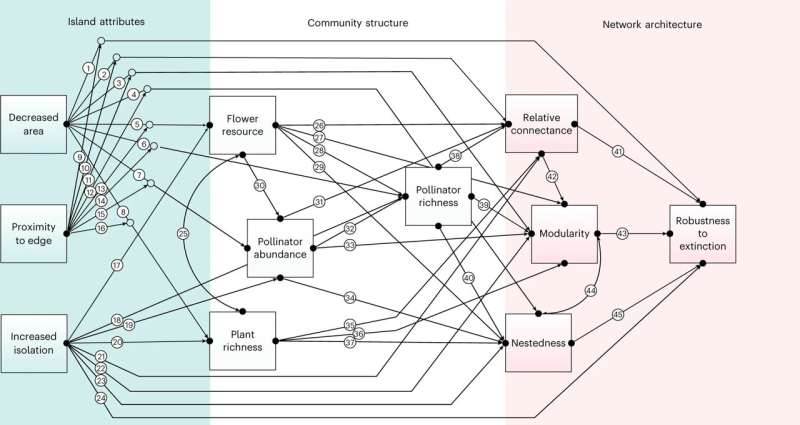This article has been reviewed according to Science X's editorial process and policies. Editors have highlighted the following attributes while ensuring the content's credibility:
fact-checked
peer-reviewed publication
trusted source
proofread
Unexpected benefits from pollinators at edges of second-growth forests

A new study has found open, light-filled forest edges support more flowers and pollinators than the dark interior of second-growth forests and the value of these areas should not be overlooked.
The study, Forest edges increase pollinator network robustness to extinction with declining area, by researchers at The University of Western Australia, Zhejiang University in China and CSIRO—Australia's national science agency, was published in Nature Ecology & Evolution.
Researchers found the interior of dense secondary forests harbored a low diversity of flowering native plants and insect pollinator species—in stark contrast to the complex patchiness of gaps and clearings found in natural forests, where higher light levels stimulated abundant floral resources that supported diverse plant-pollinator networks.
Co-author Professor Raphael Didham, from UWA's School of Biological Sciences and CSIRO, said most other studies had focused on the effects of habitat loss on pollinator communities in open habitat systems—such as grasslands croplands or savannah woodlands—where edge effects were likely to be negative or neutral.
"In our research, we found that forest edges have unexpected beneficial effects on pollinator networks by buffering floral resource availability in declining forest areas," Professor Didham said.
"We observed that many insect pollinators actually preferred open sunny conditions created by forest edge disturbance."
Over three years, in the Thousand Island Lake region of eastern China, the team recorded almost 20,000 pollination interactions between 313 insect species and 68 flowering plant species along the edge and interior gradients of 41 regenerating forest islands and 16 mainland reference sites.
The research found plant richness and floral resource availability declined with decreasing forest area at both interior and edge sites, but surprisingly edges maintained 10-fold higher pollinator abundance and richness regardless of area loss.
"In areas where there is little old-growth forest left and a strong move toward reforestation—for erosion control, carbon offsetting or biodiversity conservation—care is needed to avoid pollinator loss," he said.
"Dense closed secondary forests do not have the right environmental conditions or floral resources for many pollinators. This does not mean that forest fragmentation or edge creation are 'good' for biodiversity, in general, but they do have an unexpected beneficial role to play in regenerating forests."
The findings suggest tree-planting initiatives need to diversify spatial planning to build better forests for pollinators.
More information: Peng Ren et al, Forest edges increase pollinator network robustness to extinction with declining area, Nature Ecology & Evolution (2023). DOI: 10.1038/s41559-022-01973-y
Journal information: Nature Ecology & Evolution
Provided by University of Western Australia




















